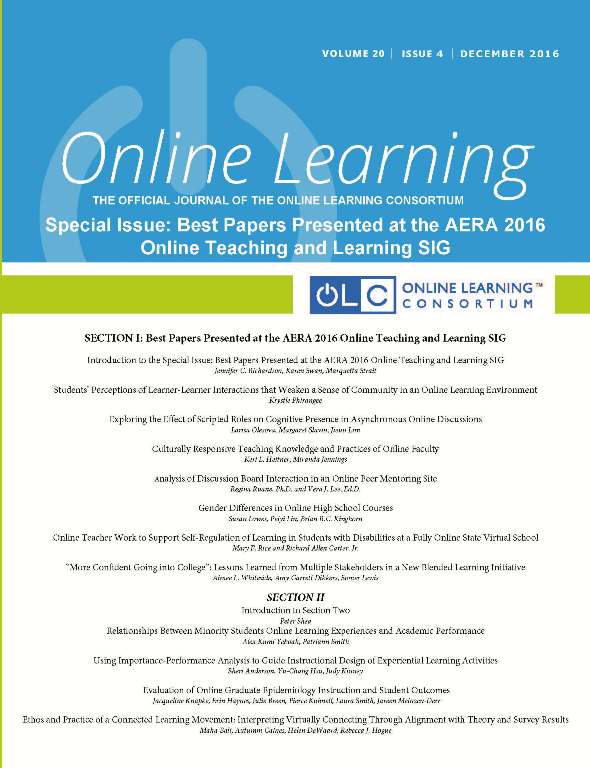Using Importance-Performance Analysis to Guide Instructional Design of Experiential Learning Activities
DOI:
https://doi.org/10.24059/olj.v20i4.732Keywords:
Importance-performance analysis, distance education, experiential learning, onlineAbstract
Designing experiential learning activities requires an instructor to think about what they want the students to learn. Using importance-performance analysis can assist with the instructional design of the activities. This exploratory study used importance-performance analysis in an online introduction to criminology course. There is limited research on experiential learning in online courses as well as empirical data to assist with the instructional design of the experiential learning activities. The primary goal of this article is to demonstrate the use of importance- performance analysis to guide the instructional design of experiential learning activities.References
Allen, I. E., & Seaman, J. (2014). Grade change: Tracking online education in the United States. Babson Survey Research Group and Ouahog Research Group.
Baruch, Y., & Holtom, B. C. (2008). Survey response rate levels and trends in organizational research. Human Relations, 61(8), 1139-1160.
Boss, J. A. (1994). The effect of community service work on the moral development of college ethics students. Journal of Moral Education, 23(2), 183-198.
Bringle, R. G., & Kremer, J. F. (1993). Evaluation of an intergenerational serviceâ€learning project for undergraduates. Educational Gerontology: An International Quarterly, 19(5), 407-416.
Carver, R. L. (1997). Theoretical underpinnings of service learning. Theory into Practice, 36(3), 143-49.
Cohen, J., & Kinsey, D. F. (1994). “Doing Good" and Scholarship: A Service-Learning Study. Journalism Educator, 48(4), 4-14.
Cohen, J. (1988). Statistical power analysis for the behavioral sciences (2nd ed.). Hillsdale, NJ: Lawrence Erlbaum Associates.
Eyler, J., Giles, D. E., Jr., Stenson, C. M, & Gray, C. J. (2001). At a glance: What we know about the effects of service-learning on college students, faculty, institutions, and communities, 1993-2000: Third Edition. Nashville, TN: Vanderbilt University.
Giles Jr., D. E., & Eyler, J. (1994). The impact of a college community service laboratory on students' personal, social, and cognitive outcomes. Journal of Adolescence, 17(4), 327-339.
Giles, D. E. Jr., & Eyler, J. (1994). The theoretical roots of service-learning in John Dewey: Toward a theory of service-learning. Michigan Journal of Community Service Learning, 1(1), 77-85.
Huybers, T. (2014). Student evaluation of teaching: the use of best–worst scaling. Assessment & Evaluation in Higher Education, 39(4), 496-513.
Lewis, R. (2004). Importance-performance analysis. Australasian Journal of Engineering Education, 2, 1-8.
Karns, G. L. (2005). An update of marketing student perceptions of learning activities: Structure, preferences, and effectiveness. Journal of Marketing Education, 27(2), 163-171.
Kolb, D. A., Boyatzis, R. E., & Mainemelis, C. (2001). Experiential learning theory: Previous research and new directions. Perspectives on thinking, learning, and cognitive styles, 1, 227-247.
Kolb, A. Y., & Kolb, D. A. (2005). Learning styles and learning spaces: Enhancing experiential learning in higher education. Academy of Management Learning & Education, 4(2), 193-212.
Kolb, A. Y., & Kolb, D. A. (2009). The learning way: Meta-cognitive aspects of experiential learning. Simulation & Gaming, 40(3), 297-327.
Kolb, D. A., & Lewis L. H. (1986). Facilitating experiential learning: Observations and reflections. New Directions for Continuing Education, 30, 99-107.
Malvey, D. M., Hamby, E. F., & Fottler, M. D. (2006). E-service learning: A pedagogic innovation for healthcare management education. Journal of Health Administration Education, 33(2), 181-198.
Markus, G. B., Howard, J. P., & King, D. C. (1993). Notes: Integrating community service and classroom instruction enhances learning: Results from an experiment. Educational Evaluation and Policy Analysis, 15(4), 410-419.
McGorry, S. Y. (2012). No significant difference in service learning online. Journal of Asynchronous Learning Networks, 16(4), 45-54.
Oh, H. (2001). Revisiting importance–performance analysis. Tourism management, 22(6), 617-627.
Petkus, E. Jr. (2000). A theoretical and practical framework for service-learning in marketing: Kolb's experiential learning cycle. Journal of Marketing Education, 22(1), 64-70.
Siniscalchi, J. M., Beale, E. K., & Fortuna, A. (2008). Using importanceâ€performance analysis to evaluate training. Performance Improvement, 47(10), 30-35.
Toncar, M. F., Reid, J. S., Burns, D. J., Anderson, C. E., & Nguyen, H. P. (2006). Uniform assessment of the benefits of service learning: The development, evaluation, and implementation of the SELEB scale. Journal of Marketing Theory & Practice, 14(3), 223-238. doi:10.2753/MTP1069-6679140304
Waldner, L. S., McGorry, S. Y., & Widener, M. C. (2010). Extreme e-service learning (XE-SL): E-service learning in the 100% online course. Merlot Journal of Online Learning and Teaching, 6(4), 839-851.
Waldner, L. S., McGorry, S. Y., & Widener, M. C. (2012). E-service-learning: The evolution of service-learning to engage a growing online student population. Journal of Higher Education Outreach and Engagement, 16(2), 123-150.
Downloads
Published
Issue
Section
License
As a condition of publication, the author agrees to apply the Creative Commons – Attribution International 4.0 (CC-BY) License to OLJ articles. See: https://creativecommons.org/licenses/by/4.0/.
This licence allows anyone to reproduce OLJ articles at no cost and without further permission as long as they attribute the author and the journal. This permission includes printing, sharing and other forms of distribution.
Author(s) hold copyright in their work, and retain publishing rights without restrictions






